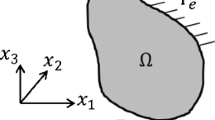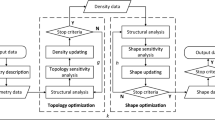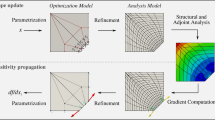Abstract
Gradient-based shape optimization processes of mechanical components require the gradients (sensitivity) of the magnitudes of interest to be calculated with sufficient accuracy. The aim of this study was to develop algorithms for the calculation of shape sensitivities considering geometric representation by parametric surfaces (i.e. NURBS or T-splines) using 3D Cartesian h-adapted meshes independent of geometry. A formulation of shape sensitivities was developed for an environment based on Cartesian meshes independent of geometry, which implies, for instance, the need to take into account the special treatment of boundary conditions imposed in non body-fitted meshes. The immersed boundary framework required to implement new methods of velocity field generation, which have a primary role in the integration of both the theoretical concepts and the discretization tools in shape design optimization. Examples of elastic problems with three-dimensional components are given to demonstrate the efficiency of the algorithms.


















Similar content being viewed by others
References
Abel JF, Shephard MS (1979) An algorithm for multipoint constraints in finite element analysis. Int J Numer Methods Eng 14(3):464–467
Akgün MA, Garcelon GH, Haftka RT (2001) Fast exact linear and nonlinear structural reanalysis and the sherman-morrison-woodbury formulas. Int J Numer Methods Eng 50(7):1587–1606
Arora JS (1993) An exposition of the material derivative approach for structural shape sensitivity analysis. Comput Methods Appl Mech Eng 105(1):41–62
Arora JS, Lee TH, Cardoso JB (1992) Structural shape sensitivity analysis: relationship between material derivative and control volume approaches. AIAA J 30(6):1638–1648
Belegundu D, Zhang S, Manicka Y, Salagame R (1991) The natural approach for shape optimization with mesh distortion control. Technical report. Penn State University, State College
Bennett JA, Botkin ME (1985) Structural shape optimization with geometric problem description and adaptive mesh refinement. AIAA J 23(3):459–464
Bischof C, Carle A, Khademi P, Mauer A (1996) The adifor 2.0 system for the automatic differentiation of fortran 77 programs. IEEE Comput Sci Eng 3(3):18–32
Braibant V, Fleury C (1984) Shape optimal design using b-splines. Comput Methods Appl Mech Eng 44(3):247–267
Bugeda G, Oliver J (1993) A general methodology for structural shape optimization problems using automatic adaptive remeshing. Int J Numer Methods Eng 36(18):3161–3185
Cho S, Ha SH (2009) Isogeometric shape design optimization: exact geometry and enhanced sensitivity. Struct Multidiscip Optim 38(1):53–70
Choi K, Kim N (2005) Structural sensitivity analysis and optimization, mechanical engineering series, vol 1. Springer, Berlin, Heidelberg
Choi KK, Chang KH (1994) A study of design velocity field computation for shape optimal design. Finite Elem Anal Des 15(4):317–341
Choi KK, Duan W (2000) Design sensitivity analysis and shape optimization of structural components with hyperelastic material. Comput Methods Appl Mech Eng 187(1–2):219–243
Choi KK, Twu SL (1989) Equivalence of continuum and discrete methods of shape design sensitivity analysis. AIAA J 27(10):1419–1424
Choi MJ, Cho S (2014) Isogeometric shape design sensitivity analysis of stress intensity factors for curved crack problems. Comput Methods Appl Mech Eng 279:469–496
Chowdhury MS, Song C, Gao W (2014) Shape sensitivity analysis of stress intensity factors by the scaled boundary finite element method. Eng Fract Mech 116:13–30
Doctor LJ, Torborg JG (1981) Display techniques for octree-encoded objects. IEEE Comput Graph Appl 1(3):29–38
El-Sayed MEM, Zumwalt KW (1991) Efficient design sensitivity derivatives for multi-load case structures as an integrated part of finite element analysis. Comput Struct 40(6):1461–1467
Escobar JM, Montenegro R, Rodríguez E, Cascón JM (2014) The meccano method for isogeometric solid modeling and applications. Eng Comput 30(3):331–343
Farhat C, Lacour C, Rixen D (1998) Incorporation of linear multipoint constraints in substructure based iterative solvers. Part 1: a numerically scalable algorithm. Int J Numer Methods Eng 43(6):997–1016
Fuenmayor FJ, Domínguez J, Giner E, Oliver JL (1997) Calculation of the stress intensity factor and estimation of its error by a shape sensitivity analysis. Fatigue Fract Eng Mater Struct 20(5):813–828
Fuenmayor FJ, Oliver JL, Ródenas JJ (1997) Extension of the Zienkiewicz-Zhu error estimator to shape sensitivity analysis. Int J Numer Methods Eng 40(8):1413–1433
Gil AJ, Arranz-Carreño A, Bonet J, Hassan O (2010) The immersed structural potential method for haemodynamic applications. J Comput Phys 229(22):8613–8641
Giner E, Fuenmayor FJ, Besa AJ, Tur M (2002) An implementation of the stiffness derivative method as a discrete analytical sensitivity analysis and its application to mixed mode in LEFM. Eng Fract Mech 69(18):2051–2071
Griewank A, Juedes D, Utke J (1996) ADOL-C, a package for the automatic differentiation of algorithms written in C/C++. ACM Trans Math Softw (TOMS) 22(2):131–167
Ha SH, Choi K, Cho S (2010) Numerical method for shape optimization using T-spline based isogeometric method. Struct Multidiscip Optim 42(3):417–428
Haftka RT (1993) Semi-analytical static nonlinear structural sensitivity analysis. AIAA J 31(7):1307–1312
Haftka RT, Adelman H (1989) Recent developments in structural sensitivity analysis. Struct Optim 1(3):137–151
Haftka RT, Barthelemy B (1989) Discretization methods and structural optimization—procedures and applications. In: Proceedings of a GAMM-Seminar October 5–7, 1988, Siegen, FRG, Springer, Berlin, Heidelberg, chap On the Accuracy of shape sensitivity derivatives, pp 136–144
Haslinger J, Jedelsky D (1996) Genetic algorithms and fictitious domain based approaches in shape optimization. Struc Optim 12:257–264
Hughes TJR, Cottrell JA, Bazilevs Y (2005) Isogeometric analysis: CAD, finite elements, NURBS, exact geometry, and mesh refinement. Comput Methods Appl Mech Eng 194:4135–4195
Iman MH (1982) Three-dimensional shape optimization. Int J Numer Methods Eng 18(5):661–673
Jackins CL, Tanimoto SL (1980) Oct-tree and their use in representing three-dimensional objects. Comput Graph Image Process 14(3):249–270
Kanninen MF, Popelar CH (1985) Advanced fracture mechanics. Oxford Engineering Science Series. Oxford University Press, Oxford
van Keulen F, Haftka R, Kim N (2005) Review of options for structural design sensitivity analysis. Part I: linear systems. Comput Methods Appl Mech Eng 194(30–33):3213–3243
Kibsgaard S (1992) Sensitivity analysis-the basis for optimization. Int J Numer Methods Eng 34(3):901–932
Kiendl J, Schmidt R, Wüchner R, Bletzinger KU (2014) Isogeometric shape optimization of shells using semi-analytical sensitivity analysis and sensitivity weighting. Comput Methods Appl Mech Eng 274:148–167
Kirsch U (2002) Design-oriented analysis: a unified approach. Springer Netherlands, Dordrecht
Kunisch K, Peichl G (1996) Numerical gradients for shape optimization based on embedding domain techniques. Comput Optim 18:95–114
Lee BY (1996) Consideration of body forces in axisymmetric design sensitivity analysis using the bem. Comput Struct 61(4):587–596
Lee BY (1997) Direct differentiation formulation for boundary element shape sensitivity analysis of axisymmetric elastic solids. Int J Solids Struct 34(1):99–112
Li FZ, Shih CF, Needleman A (1985) A comparison of methods for calculating energy release rates. Eng Fract Mech 21(2):405–421
Li K, Qian X (2011) Isogeometric analysis and shape optimization via boundary integral. Comput Aided Des 43(11):1427–1437
Lian H, Bordas SPA, Sevilla R, Simpson RN (2012) Recent developments in the integration of computer aided design and analysis. Comput Technol Rev 6:1–36
Lian H, Kerfriden P, Bordas SPA (2016) Implementation of regularized isogeometric boundary element methods for gradient-based shape optimization in two-dimensional linear elasticity. Int J Numer Methods Eng 106(12):972–1017
Liu L, Zhang Y, Hughes TJR, Scott MA, Sederberg TW (2014) Volumetric T-spline construction using boolean operations. Eng Comput 30(4):425–439
Liu WK, Tang S (2007) Mathematical foundations of the immersed finite element method. Comput Mech 39(3):211–222
Liu WK, Liu Y, Darell D, Zhang L, Wang XS, Fukui Y, Patankar N, Zhang Y, Bajaj C, Lee J, Hong J, Chen X, Hsu H (2006) Immersed finite element method and its applications to biological systems. Comput Methods Appl Mech Eng 195(13):1722–1749
Marco O, Sevilla R, Zhang Y, Ródenas JJ, Tur M (2015) Exact 3D boundary representation in finite element analysis based on Cartesian grids independent of the geometry. Int J Numer Methods Eng 103:445–468
Marco O, Ródenas JJ, Navarro-Jiménez JM, Tur M (2017) Robust h-adaptive meshing strategy considering exact arbitrary CAD geometries in a Cartesian grid framework. Comput Struct 193:87–109
Meagher D (1980) Octree encoding: a new technique for the representation, manipulation and display of arbitrary 3-D objects by computer. Tech. Rep. IPL-TR-80-11 I, Rensselaer Polytechnic Institute
Moita JS, Infanta J, Mota CM (2000) Sensitivity analysis and optimal design of geometrically non-linear laminated plates and shells. Comput Struct 76(1–3):407–420
Nadal E (2014) Cartesian grid FEM (cgFEM): high performance h-adaptive FE analysis with efficient error control. Application to structural shape optimization. Ph.D. Thesis. Universitat Politècnica de València
Nadal E, Ródenas JJ, Albelda J, Tur M, Tarancón JE, Fuenmayor FJ (2013) Efficient finite element methodology based on cartesian grids: application to structural shape optimization. Abstract and Applied Analysis 2013
Navarrina F, López-Fontán S, Colominas I, Bendito E, Casteleiro M (2000) High order shape design sensitivities: a unified approach. Comput Methods Appl Mech Eng 188(4):681–696
Neittaanmäki P, Salmenjoki K (1989) Comparison of various techniques for shape design sensitivity analysis. In: Computer aided optimum design of structures: recent advances. Springer, Berlin, Heidelberg, pp 367–377
Nguyen VP, Anitescu C, Bordas SPA, Rabczuk T (2015) Isogeometric analysis: an overview and computer implementation aspects. Math Comput Simul 117:89–116
Ozaki I, Kimura F, Berz M (1995) Higher-order sensitivity analysis of finite element method by automatic differentiation. Comput Mech 16(4):223–234
Pandey PC, Bakshi P (1999) Analytical response sensitivity computation using hybrid finite elements. Comput Struct 71(5):525–534
Peskin CS (1977) Numerical analysis of blood flow in the heart. J Comput Phys 25:220–252
Phelan DG, Haber RB (1989) Sensitivity analysis of linear elastic systems using domain parametrization and a mixed mutual energy principle. Comput Methods Appl Mech Eng 77(1–2):31–59
Piegl L, Tiller W (1995) The NURBS book. Springer, New York
Poldneff MJ, Rai IS, Arora JS (1993) Implementation of design sensitivity analysis for nonlinear structures. AIAA J 31(11):2137–2142
Qian X (2010) Full analytical sensitivities in NURBS based isogeometric shape optimization. Comput Methods Appl Mech Eng 199(29–32):2059–2071
Rice JR (1968) A path independent integral and the approximate analysis of strain concentration by notches and cracks. J Appl Mech 35(2):379–386
Ródenas JJ (2001) Error de Discretización en el Cálculo de Sensibilidades mediante el Método de los Elementos Finitos. Ph.D. Thesis
Ródenas JJ, Fuenmayor FJ, Tarancón JE (2003) A numerical methodology to assess the quality of the design velocity field computation methods in shape sensitivity analysis. Int J Numer Methods Eng 59(13):1725–1747
Rodenas JJ, Tur M, Fuenmayor FJ, Vercher A (2007) Improvement of the superconvergent patch recovery technique by the use of constraint equations: the SPR-C technique. Int J Numer Methods Eng 70(6):705–727
Ródenas JJ, Bugeda G, Albelda J, Oñate E (2011) On the need for the use of error-controlled finite element analyses in structural shape optimization processes. Int J Numer Methods Eng 87(11):1105–1126
Rogers DF (2001) An introduction to NURBS: with historical perspective. Elsevier, London
Schramm U, Pilkey WW (1993) The coupling of geometric descriptions and finite elements using NURBs a study in shape optimization. Finite Elem Anal Des 15(1):11–34
Sevilla R, Fernández-Méndez S, Huerta A (2011) 3D-NURBS-enhanced finite element method (NEFEM). Int J Numer Methods Eng 88(2):103–125
Sevilla R, Fernández-Méndez S, Huerta A (2011) NURBS-enhanced finite element method (NEFEM): a seamless bridge between CAD and FEM. Arch Comput Methods Eng 18(4):441–484
Shiriaev D, Griewank A (1996) ADOL-F: automatic differentiation of fortran codes. Comput Differ Tech Appl Tools (SIAM) 1:375–384
Shivakumar KN, Raju IS (1992) An equivalent domain integral method for three-dimensional mixed-mode fracture problems. Eng Fract Mech 42(6):935–959
Silva CAC, Bittencourt ML (2007) Velocity fields using NURBS with distortion control for structural shape optimization. Struct Multidiscip Optim 33(2):147–159
Tur M, Albelda J, Nadal E, Ródenas JJ (2014) Imposing dirichlet boundary conditions in hierarchical cartesian meshes by means of stabilized lagrange multipliers. Int J Numer Methods Eng 98(6):399–417
Tur M, Albelda J, Marco O, Ródenas JJ (2015) Stabilized method to impose dirichlet boundary conditions using a smooth stress field. Comput Methods Appl Mech Eng 296:352–375
Wujek BA, Renaud JE (1998) Automatic differentiation for more efficient system analysis and optimization. Eng Optim 31(1):101–139
Yang RJ, Fiedler MJ (1987) Design modelling for large-scale three-dimensional shape optimization problems. ASME Comput Eng 15:177–182
Yoon BG, Belegundu AD (1988) Iterative methods for design sensitivity analysis. AIAA J 26(11):1413–1415
Zhang L, Gerstenberger A, Wang X, Liu WK (2004) Immersed finite element method. Comput Methods Appl Mech Eng 293(21):2051–2067
Zhang W, Beckers P (1989) Comparison of different sensitivity analysis approaches for structural shape optimization. In: Computer aided optimum design of structures: recent advances. Springer, Berlin, Heidelberg, pp 347–356
Zhang Y, Wang W, Hughes TJR (2013) Conformal solid T-spline construction from boundary T-spline representations. Comput Mech 6(51):1051–1059
Zienkiewicz OC, Zhu JZ (1987) A simple error estimator and adaptive procedure for practical engineering analysis. Int J Numer Methods Eng 24(2):337–357
Zienkiewicz OC, Taylor RL, Zhu J (2013) The finite element method: its basis and fundamentals, 7th edn. Butterworth-Heinemann, Oxford
Acknowledgements
The authors wish to thank the Spanish Ministerio de Economía y Competitividad for the financial support received through the project DPI2013-46317-R and the FPI program (BES-2011-044080), and the Generalitat Valenciana through the Project PROMETEO/2016/007.
Author information
Authors and Affiliations
Corresponding author
Rights and permissions
About this article
Cite this article
Marco, O., Ródenas, J.J., Fuenmayor, F.J. et al. An extension of shape sensitivity analysis to an immersed boundary method based on Cartesian grids. Comput Mech 62, 701–723 (2018). https://doi.org/10.1007/s00466-017-1522-0
Received:
Accepted:
Published:
Issue Date:
DOI: https://doi.org/10.1007/s00466-017-1522-0




